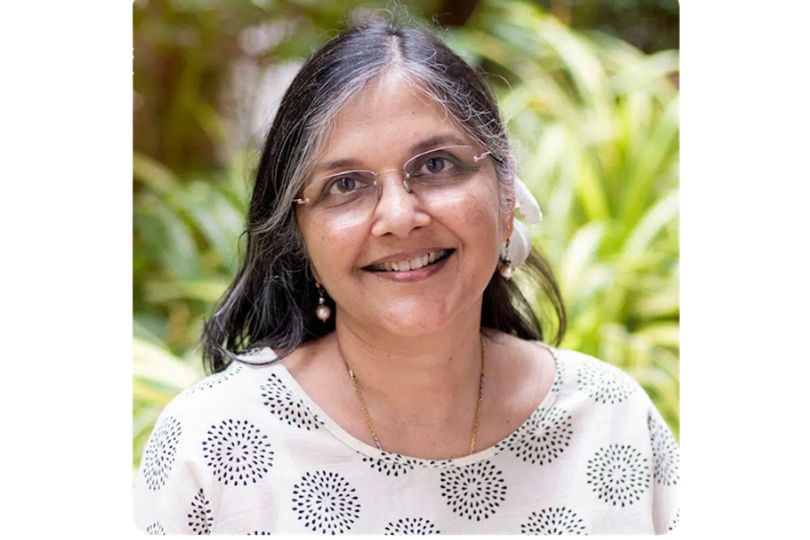Interview with Sarita Saraf Editor of “AdiDev Press”
Explore Sarita Saraf's journey from art to editing at AdiDev Press. Discover her insights on literature, spiritual texts, and children's stories.on May 06, 2024

Sarita Saraf is a writer and an artist, with an intense passion for philosophical literature. She is an author of three short English publications - Nachiketas, Socrates and Abraham Lincoln. She has also authored Rahasyamaya Agni Ke Prati Sukta, a Hindi translation of poet and mystic, Sri Aurobindo’s Hymns to the Mystic Fire. She is currently in the process of translating into Hindi, a 13-volume chronicle of the spiritual journey of mystic, Mirra Alfasa titled The Mother’s Agenda.
For the last 2 decades she has been researching and developing a repository of value-oriented stories for children, used across public schools in India. Her first story emerged as a birthday greeting to her 13-year old daughter. Ever since she fell in love with verse and is today a prolific editor and author.
Frontlist: Your journey from a designer to becoming an editor at AdiDev Press is quite intriguing. How did your background in art and design influence your transition into the world of publishing and literature?
Sarita: Art has been central since my childhood, but at sixteen, I found myself writing poetry — just a few of them, rather philosophic poems — about life and death and the passage in between. It was a phase when something turned within and started looking at life from a distance... but they were the primary steps of a child, moving towards deeper philosophic truths that would overtake my life later, at thirty-five. Shri Kireet Joshi, my friend, philosopher and guide, led me into this inner world and then encouraged me to pick up my pen as well as my brush again to reenter the outer world with a new outlook. My love for art revived. And three monographs were done during that time. The road kept opening... and I found I was simultaneously walking a double path of art and writing. I worked as a Graphic Designer at an Architecture firm for some time. This added a new dimension. Then a burst of watercolours invaded my life again! Everything helped me in my expression. A few more poems emerged during Covid. And then Adidev came along!
Frontlist: With your background in art and design, do you find that visual elements play a significant role in your writing process or in the presentation of your work? How do you incorporate visual storytelling techniques into your writing, if at all?
Sarita: Whether it is a story or a painting or a song, all are expressions of what we have within us, waiting to express itself... yes, when I read something, a line of a poem perhaps, sometimes, immediately I see an image on the inner canvas... and at other times words start dropping down into the mind...and the image follows... so, no fixed pattern, I'm afraid!
Frontlist: Your work spans various genres and mediums, from monographs to translations and children's stories. How do you navigate the different creative processes involved in each form of writing, and do you find that certain themes or ideas resonate across your diverse body of work?
Sarita: My central love is spiritual literature--Sri Aurobindo has stated: "All life is Yoga”, "Everything is to be accepted, so that everything may be transformed". This was a philosophical statement that resonated deep within. In the three monographs, including one on Abraham Lincoln, my aim was to bring out the spiritual aspect.
Swami Vivekananda speaks of 'man-making education'. Well, education begins in the cradle, the first teacher is the mother, the father, the family, the teacher, the school... there are three things that are fundamental to our inner growth, the growth of the flame within--Illumination, Heroism and Harmony. Stories are the best medium to make all these three qualities bloom in children. Kids are like sponges, their sense of wonder is phenomenal! We just need to supply the right material to invoke it! Apart from the monographs, I had already begun working on stories for children based on these themes. So, when AdiDev Press approached me, I felt very happy to work with them!
Frontlist: Translating spiritual texts requires a deep understanding of both the source material and the target language. Can you share any specific techniques or strategies you employ to ensure the essence of the original text is preserved while making it accessible to a new audience?
Sarita: Yes, spiritual text can be a challenge, especially when one has to tailor it for children! But these texts have been an inherent part of our upbringing, so it wasn’t foreign to us. We started with the Hanuman Chalisa. We were keen to be very sincere to the original text and retain the exact meaning of the shlokas. We meticulously made a word meaning table for each verse, wove it into a sentence, and simplified it into easy language and expression that a child would understand without diluting the sense.
But the real challenge was how to make it facile for the parents to navigate through the source material in the easiest way possible… so the word-meaning table vanished, and everything was put in simple sight! And we made sure that both art and text share the responsibility of expressing the divine story! A lot of R&D went into it, but it was worth it!
My first Hanuman Chalisa was very well received and we were happy to follow it up with our My first Prayer to Lord Rama. In the prayer series we have Achyutashtakam in the pipeline, and a box set of shlokas coming soon. This will include shloka books on our deities — Sri Ganesha, Vishnu, Shiva, Goddess Lakshmi, Saraswati and Durga. And our work still continues. We are working on more books in the prayer series.
Frontlist: As an editor, what criteria do you consider when selecting manuscripts for publication at AdiDev Press? Are there specific genres or themes that you're particularly drawn to, and how do you balance commercial appeal with literary merit?
Sarita: Two things are of prime importance in literary works--substance, and form or what we call expression. Both are indispensable. Sometimes authors have great ideas, but the form is not up to the mark; sometimes, it's the other way around!
But, for me there is no compromise--first and foremost the substance has to be there, what do we want to say? Is it going to help in their character development? Is it illuminating the intellect, or invoking heroism, or harmony in their being? Or inspiring soul qualities like patience, sensitivity, love, strength, courage, perseverance, friendship, sharing, kindness etc. Is it expanding their knowledge base? Is it deepening a love for their country, for humanity? Will it touch a deep chord within?
Then the form: the rhyme and rhythm, crispness of text. Then, should it be prose or poetry? How long should it be? It's important to hold the attention of the child. Children's books need to tell a story, It's the best way to pass on a value, through an example. It can be a real story of a great personality, or it could be fictional. Humour is important too! If a story can make a child laugh while it conveys a value, it is far more effective.
And the illustrations! The eyes are attracted first to the illustrations. They speak a lot. There are things that can be expressed through the pictures and need not be part of the text. In fact, there are some brilliant story books in which text conveys 5% of the story; the pictures speak the rest!
One very important point about story writing is that when we tell our stories, we must ensure that our young audience is familiar with the events in the book. For example, you want to speak about honesty. You decide to tell a story about a baseball player who confesses that he crossed the line and, therefore, he is out, even though the umpire does not declare him so! Now, in India, baseball is not played; we must change the game to cricket, basketball or hockey! Otherwise, the child will lose interest in the story. So, these things have to be kept in mind. Another thing I’m particular about is that if you are telling a historical story, always give a map pointing out the place where this story is based. It helps to orient him. It makes it more real to the child. And if the child were to go there during his holidays, he would relive it!
Books need to be aesthetically sound. Everything comes together to make a fine book... it is not enough that the text is good, the illustrations are good. If the paper quality or the printing is substandard, it defeats the purpose.
Books can involve all three senses: sight, sound, and touch. Therefore, we use technology when and where needed and audio where necessary. For example, we have brought out a book on Hanuman Chalisa and Sri Ramchandra. We have added audio that can be played by scanning a QR code given in the book. This helps young mothers who would like that their little ones hear the Chalisa or the Ramastuti sung out or they want to sing along when they read out these books. And there is another book, Colours with Radha Krishna, in which we have used gold and silver foil to illustrate the terms "golden and silver". Nothing is too much for our little ones!
I believe that if these have been taken care of, the commercial appeal will take care of itself! What we create is what is read to children, what is read is what moulds their minds, their feelings, and their character. So, there is a great responsibility on the shoulders of authors and publishers. If we are confident, we will find that it is we who define commercial appeal and not the other way round. We need to focus on creating books that help in the blossoming of our children.
Frontlist: Looking ahead, what legacy do you hope to leave through your work in literature and publishing? How do you envision continuing to serve the joy of writing and creating the joy of reading for generations to come?
Sarita: We would like to surround kids with beauty: beauty of thought and beauty of form, because books shape our character and expression.
For example: When a child reads a very well written and illustrated story based on kindness, which touches a chord in his heart, we would have done our job well. If the text was beautifully expressed, which found its way into his being, became a part of his expression, we would have done our job well. The story impacts his character and the quality of language impacts his ability to express. Little by little it influences his expression.
I believe that we ought to reach out to the soul of a child and let it shine out in his life as he plays, as they eat, as he studies, as he thinks and feels. To make him conscious of all that he is and has within him, and to all that is there around him outside. Go from near to far, invoke love for family, community, country, and humanity, invoke a thirst for knowledge, an aspiration for beauty… lay the foundation so strong that he finds himself walking the 'Sunlit Path', through the easy and difficult passages of life.
If we can provide a little of that foundation through our books, it would fulfill my aspiration as a story-teller....



.jpg)






.jpg)

.jpg)
.jpg)
.jpg)

.jpg)
.jpg)










Sorry! No comment found for this post.